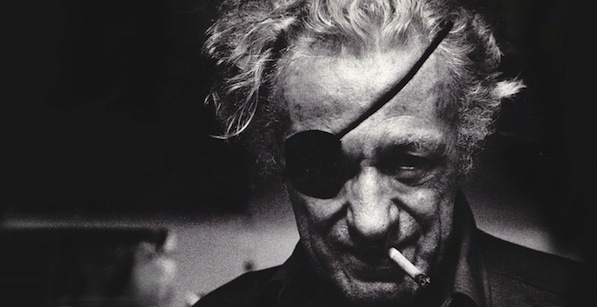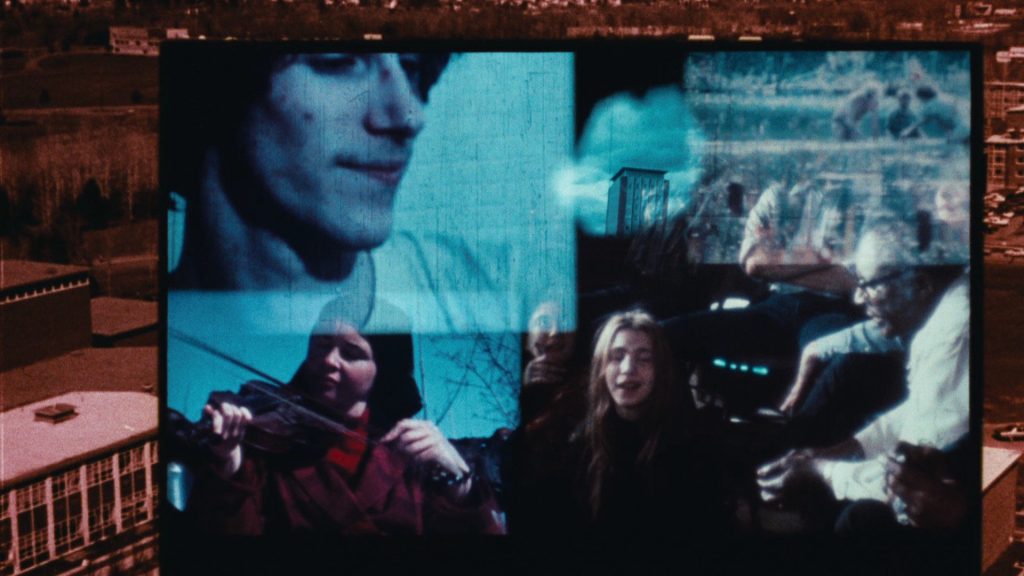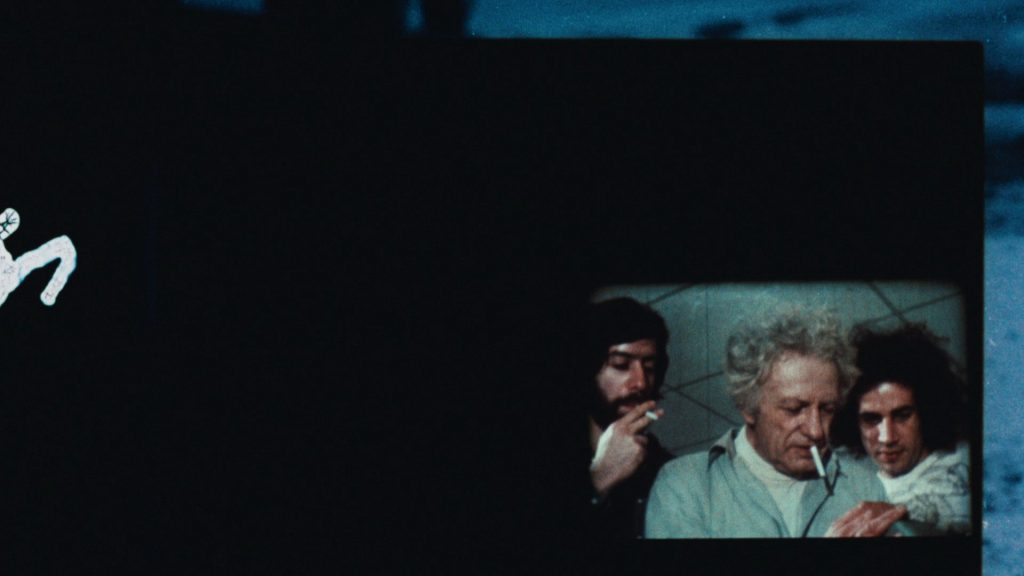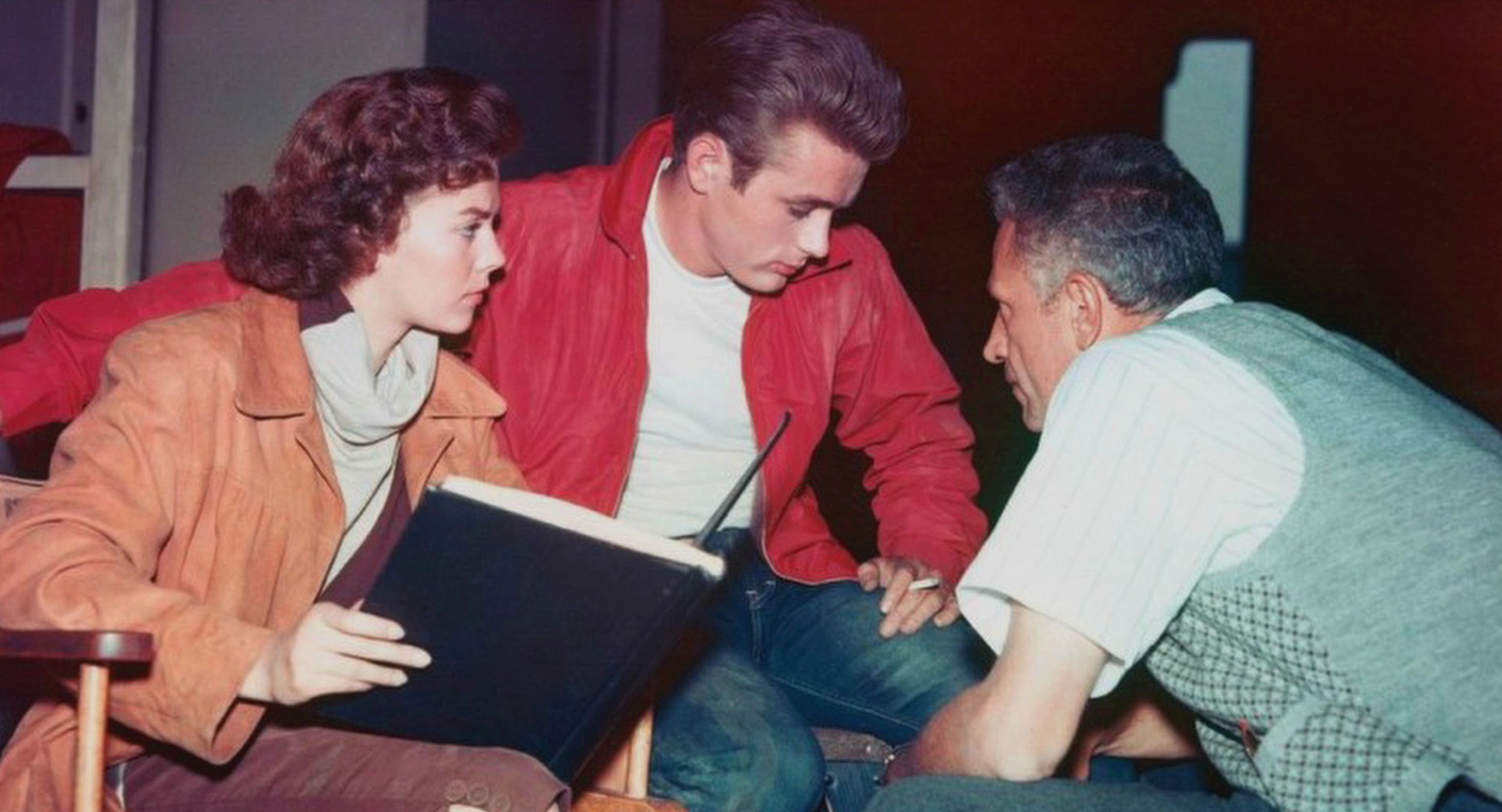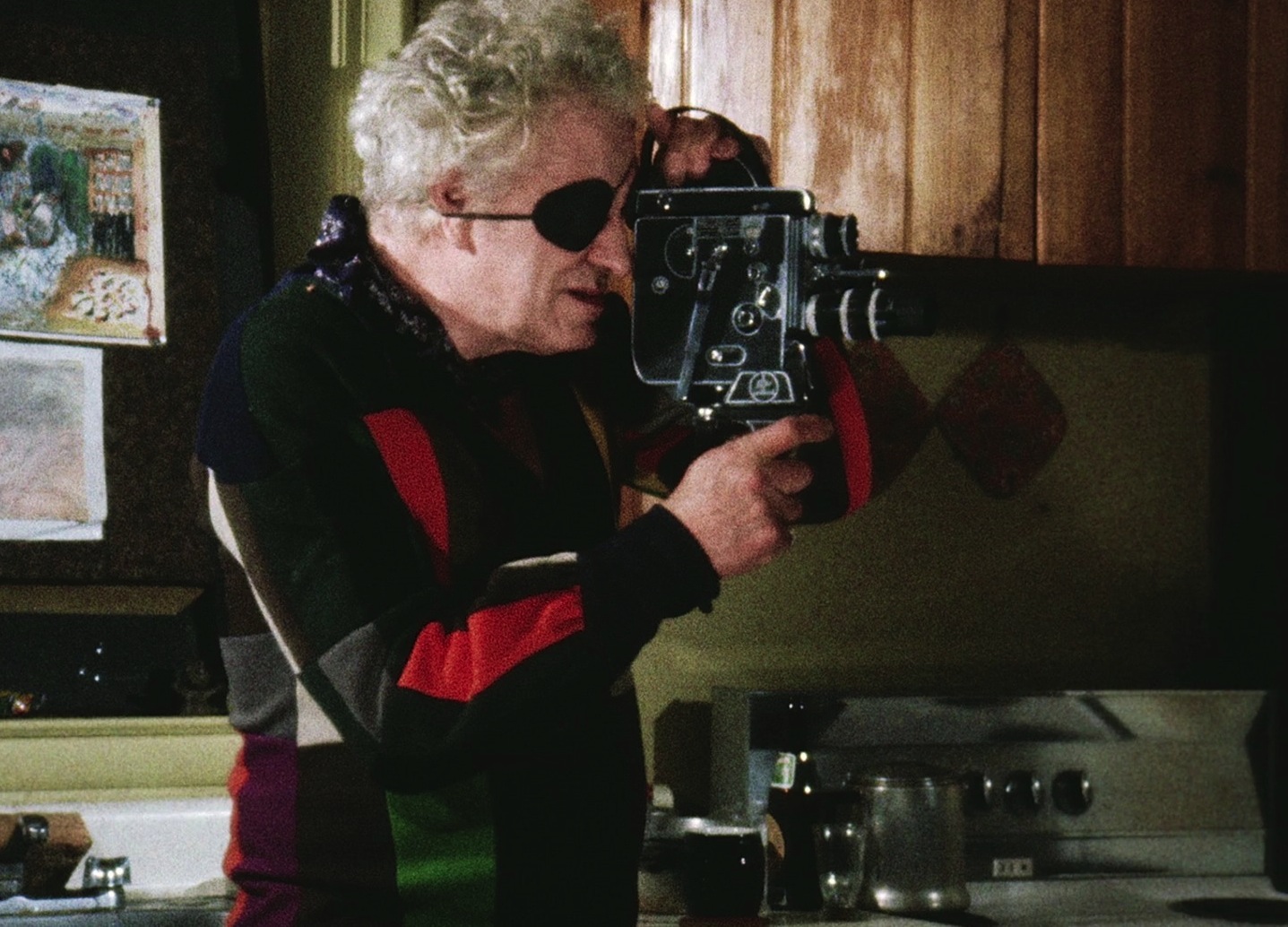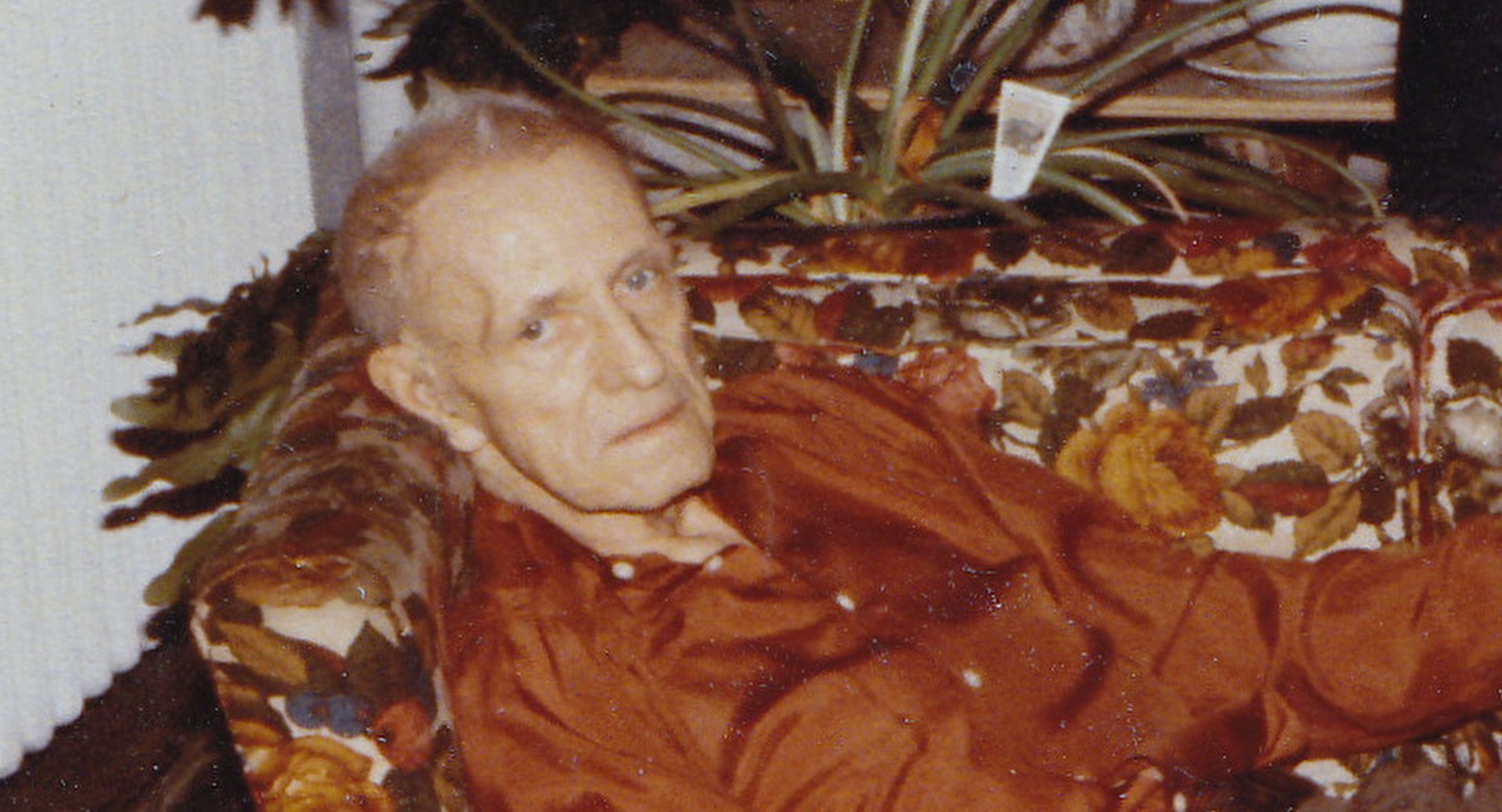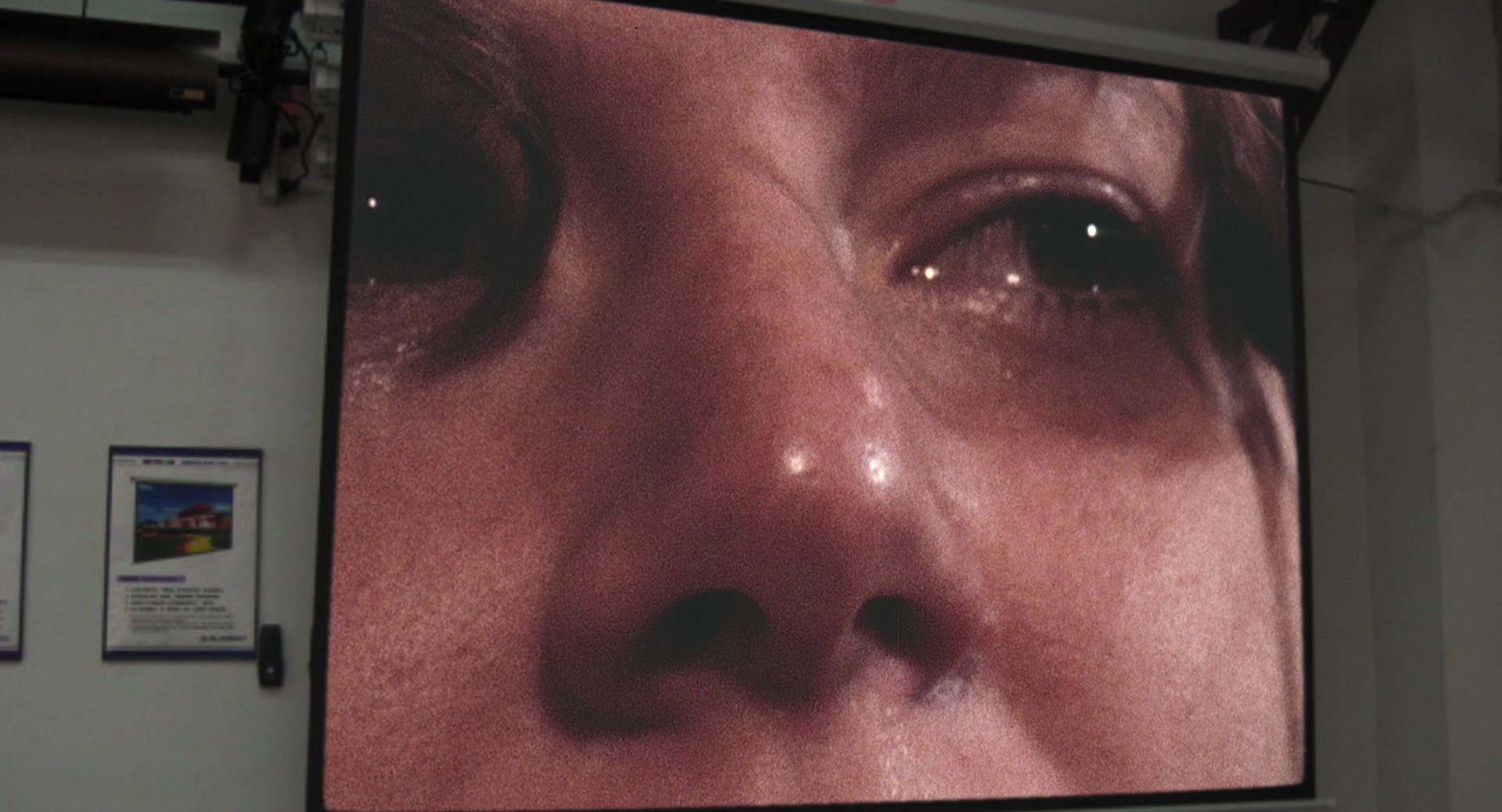Leonard Cohen, as his fans know, wisely distinguishes between a holy hallelujah and a broken hallelujah. This, more or less, is how he described the difference on stage in Melbourne in 1985: whereas the holy sort accompanies traditionally beautiful kinds of visions (landscapes, churches, and so on), the other, broken kind happens when you are taking in the awesome racks of meat hanging up on hooks at the butcher’s shop, and the only possible response is: hallelujah!
There are awesome beauties in the cinema of Nicholas Ray—Joan Crawford and Sterling Hayden kissing near a waterfall in the closing moments of Johnny Guitar (1954), for instance – and there is the no less significant monument of an utterly broken epic that, today, brings forth a hallelujah: We Can’t Go Home Again. In it, Ray (who turned sixty in the early stages of its making) hurled himself into a completely experimental process, risking everything he had, or could get his hands on: a raw, fragmented film about the situation and emotions of youth in America at the start of the 1970s—a film which may have erupted, at its moment of initiation, as a type of psychodrama, but which quickly came to be worked (and then endlessly reworked) into a prismatic, reflective form on many interconnected and overlapping screens.
We Can’t Go Home Again, in the version recently restored by Susan Ray and her collaborators (including Richie Bock from the original crew), hurls the viewer directly into its maelstrom of images and sounds, actions (the word “action” was dear to Nicholas Ray) and narrative fragments, colors and movements. A maximum of five screens blazing simultaneously—sometimes less, sometimes only one, with often the images pulled through the soupy color treatment of an early video synthesizer (Ray was inspired by Nam June Paik). Ray was in tune with a major current in contemporary art of the day—and still in our day, as witnessed by the videos of Pipilotti Rist—in his determination to “destroy the rectangle” of the classically proportioned and centered pictorial frame, a tendency that had always been latent in the frequently off-kilter and on-the-fly compositions of his Hollywood studio productions, such as Party Girl (1958).
“Don’t expect too much:” this line, which ends a funny, teacherly story that Nick tells in the film, and that Susan picks up as the title for her documentary portrait, says something grand about life itself, and also something simple and fundamental about the project of We Can’t Go Home Again: the edits (both visual and aural) are as rough as guts, machines whirr loudly while voices whisper, camera focus and light levels vary wildly, and the assembled whole constantly threatens to collapse into its multitude of heterogeneous parts … But—and this is precisely what Ray gambled upon in his artistic gesture—there remains the trace of something alive in this experiment, on the levels both of content and of form.
First, the form. Ray’s prodigious experiment with multiple screens has been compared to everything from Brian De Palma’s early split-screen constructions to proto-IMAX exhibitions (popular at World Expo’s since the early 1960s) of the “whole world in images.” One crucial aspect of the pictorial mosaic, faithfully restored by Susan Ray, is often neglected in commentary on the work: the primary screen (made of many screens) itself sits within another, larger screen, a serene image-backdrop—a very classical, balancing effect, as if owing something to a venerable tradition in painting (and in the documentary, we see that Nick indeed painted his vision of how this arrangement would work). Serge Daney noticed this in 1980 (a translation of his text appears in the materials provided with the splendid Oscilloscope DVD/Blu-ray of We Can’t Go Home Again/Don’t Expect Too Much), although few readers of even Cahiers du cinéma may have been aware of exactly what he was describing: he speaks of a “dark background” which is “sometimes the shadow of a house, with a roof, just like children draw them. No longer a house for characters, but a house for images which have ‘lost their home’: the cinema.” In 2014, spectators (particularly those on-line) are likely to make a newer connection: this backdrop or home for the vagrant images that constitute the film resembles nothing so much a homely computer desktop. Once again, Nicholas Ray was ahead of his time.
Now the content. When Ray was asked, by Ken Jacobs and other faculty of the Harpur College of Arts and Sciences at Binghamton University (upstate New York), to teach filmmaking, he announced a collective project, it seems, instantly upon arrival: the only way for students to learn filmmaking is to do it—and to take a shot at every role in the process, rather than specialize. So off they all went—usually based, not in the classroom (god forbid), but at Ray’s own farm residence. (The animosity that Ray’s anarchic methods stirred in Jacobs has been vividly documented in the book Optic Antics: The Cinema of Ken Jacobs, edited by Michele Pierson, David E. James, and Paul Arthur, Oxford University Press, 2011.) Ray started in by immediately fictionalizing his own role as a teacher amidst a group of young people—some of them cinephiles aware (and in awe) of his Hollywood past, others rope-ins just there for the unfolding “happening.”
In the event, it unfolded on at least two levels simultaneously. Ray wanted the work to be not a documentary, but a type of seismograph: an on-the-spot re-enactment, psychodramatically inflected, of what the students were experiencing and feeling in their lives in and beyond the university. On this level, as Don’t Expect Too Much explicates well, We Can’t Go Home Again registered a certain change in the air of the times: “That marching moment was over,” as one participant declares in retrospect, with a “period of withdrawal” marking a search for self in place of the angry, communal protests of the 1960s. Ray’s vision was canny, mixing optimism with fatalism: when the self goes to the mirror, it can just as easily get lost in the depths of its own murky reflection, as find liberation there.
We Can’t Go Home Again explodes with scenes of violence and abuse (frequently staged as grotesque, black comedy), often centered on the figure of Leslie Levinson; and then it implodes into tableaux of breakdown, solitude and paralysis (such as the long, painful, frequently cited scene of Tom Farrell shaving off his beard—an experience he recalls as a key moment in his life). Ray was channelling this content from the outside, but he was also projecting it from the inside: the film presents an agonized, often self-lacerating exercise in autobiography (something he would continue, in another register, with Wim Wenders on the Lightning Over Water [1980] project). Many parts and times of Ray’s life are discernible here, from his experience of Frank Lloyd Wright’s “communal pedagogy” in the 1930s, to his intimate involvements (and intense identification) with the young stars of Rebel Without a Cause in 1955.
Serge Daney summarized this aspect of the work well: it is, in Ray’s career, “another film on fathers who are not fathers, who trick the Oedipus complex, mime their own death, tie knots we won’t be able to cut”—this last phrase a gruesome reference to one of several death/suicide scenes that Ray enacts in the movie. In other words, a film that is—like Ray, and like the generation he was keenly in the process of observing—in flight from the traditional notion of the nuclear family, and yet in search of another, expanded, alternative model of family living. Ray clearly both enjoyed and resisted the role of patriarch: opposed to all authority, he was (as Susan Ray notes) the ultimate authoritarian, on the set as well as in the post-production room.
Jonathan Rosenbaum, who was in the right place at the right time to experience We Can’t Go Home Again in 1973, wrote in 2012 that Nick Ray’s “effort to apply [his] vision to low-budget seventies filmmaking is advanced and expressive only in its multi-image mosaic format and its emotional impact, which resembles a scream. Otherwise, it can only replicate the breadth of its anguish and despair, not offer any strategies for transcendence.” He further argues: “Once politics becomes confused with psychoanalysis, neither can function with much purpose”—although I am not certain that such a blanket statement could cover the achievements of Dusan Makavejev or Marco Ferreri in the same period. Coherent or not, Ray’s aim was certainly to confuse politics and psychoanalysis, ongoing historic events and internal turmoil, righteous anger and loving desire. Intriguingly, Rosenbaum’s verdict on the ultimate dead-end of Ray’s “scream” echoes the filmmaker’s own opinion of a later, crucial multi-screen experiment of the mid 1970s, Jean-Luc Godard’s Numéro deux—he walked out in the middle of it, remarking to Daney that he found it “too hard, intellectual, self-destructive.”
Don’t Expect Too Much offers further layers to our grasp of what was going during the most intense period of We Can’t Go Home Again’s two-year production—from first day of class in 1971 to last day of the Cannes Film Festival in 1973 (where the version—distinct from several later attempts—that forms the basis for this restoration was screened, to general bewilderment and scattered pockets of excitement). Susan Ray’s document is constructed from the rich holdings of the Nicholas Ray Archive—material that will hopefully also be reconstructed in exhibition or installation form in galleries and museums in the future. Although Nick mentioned vaguely to Daney on the streets of New York that “the reels [of We Can’t Go Home Again] were lost, somewhere, during another editing,” Susan has in fact managed to hold onto an enormous amount of material of diverse sorts: footage, audio recordings, drawings and paintings, handwritten and typed notes and so on. She builds and arranges her account carefully: the multi-screen concept enters around the thirty minute mark, while allusions to Nick’s various addictions and compulsions are reserved, unsensationally, for the fifty-two-minute spot.
When Susan presented her film and Nick’s to an eager audience at FICUNAM in Mexico in 2012, she commented that, at the moment of completing We Can’t Go Home Again and bringing it to the world at last, she realized she had arrived at the same age that Nick had reached when the project was first launched: sixty. A fruitful marriage, in every sense, and a collaboration that has extended long past the biological death of one of the partners—a collaboration between the restless, tormented, whirlwind spirit of Nick and the infinite patience of Susan; between one who (due to many, complex circumstances) was unable to pull the work together into a fully finished form, and the other who stuck with it, slowly gathering the alliances and resources necessary to see the job through. Although Ray’s hard-won despair about the impossibility of ever “going home again”—of returning to any point of origin or innocence—was profound (again, in every sense), Susan has proven, with her perseverance and endurance, that at least something can be brought back, not pristine and whole but fully living, from long ago. We are all the richer for her effort.
This work of homage, which began with the marvelous book I Was Interrupted: Nicholas Ray on Making Movies (University of California Press, 1995), and continues with these two films, is not yet over: another project of the Nicholas Ray Foundation, titled Action! Master Class with Nicholas Ray, will be devoted specifically to his teachings. After that, Susan declares, she has her own projects to complete. It is surely time for that. Her husband’s flame is being carried by many others now—as evidenced in the new collection Lonely Places, Dangerous Ground: Nicholas Ray in American Cinema (SUNY Press, 2014), edited by Steven Rybin and Will Scheibel, that concludes, fittingly, with the double-punch knockout of Rybin’s essay “The Pedagogical Aesthetics of We Can’t Go Home Again,” and an interview from the era by long-time Ray aficionado Bill Krohn, titled “The Class”.
Serge Daney concluded his 1980 piece on Ray with a fine flourish: “No Cinémathèque in the world can sleep peacefully with the thought that it doesn’t have in its storeroom a copy of We Can’t Go Home Again.” Thanks to digital restoration, it can now sit, actually or virtually, in all our storerooms. And what, finally—now that we can see and re-see and ponder it—was it all about? “If it’s not clear,” says Nicholas Ray on the soundtrack of Don’t Expect Too Much, “then let it become clear.”

